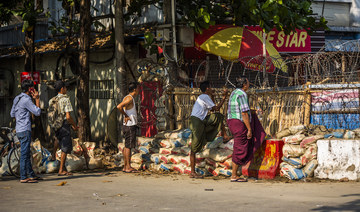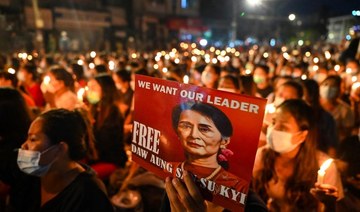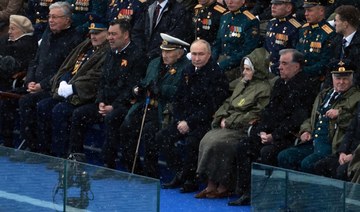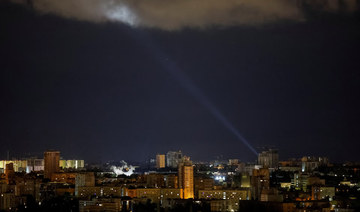JAKARTA: Indonesian President Joko Widodo on Friday called for democracy to be restored and violence to be halted in Myanmar and for Southeast Asian leaders to hold a high-level meeting to discuss the situation there.
“I will immediately call the Sultan of Brunei Darussalam as head of ASEAN to as soon as possible hold a high-level ASEAN meeting to discuss the crisis in Myanmar,” he said in a virtual address. Brunei is currently chair of the 10-member Association of Southeast Asian Nations (ASEAN).
Indonesia president calls for ASEAN high level meeting on Myanmar crisis
https://arab.news/yft2f
Indonesia president calls for ASEAN high level meeting on Myanmar crisis

- Brunei is currently chair of the 10-member Association of Southeast Asian Nations
Police arrest dozens as they break up pro-Palestinian protests at several US universities

- Israel has killed more than 34,700 Palestinians, according to Gaza’s Health Ministry
- Nearly 2,900 people have been arrested at 57 colleges and universities
NEW YORK: Police made dozens of arrests as pro-Palestinian protest encampments were dismantled Friday at the University of Pennsylvania and the Massachusetts Institute of Technology, hours after police tear-gassed demonstrators and took down a similar camp at the University of Arizona.
Philadelphia and campus police at Penn took action around daybreak to remove protesters from an encampment in place for more than two weeks. School officials said protesters were given warnings and the chance to leave without being detained. About 33 people, including faculty members and seven students, were among those arrested and charged with trespass, the school said.
Protest camps have sprung up across the US and in Europe in recent weeks as students demand their universities stop doing business with Israel or companies that support its war efforts. Organizers seek to amplify calls to end Israel’s war against Hamas in Gaza, which they describe as a genocide against the Palestinians. The top United Nations court has concluded there is a “plausible risk of genocide” in Gaza — a charge Israel strongly denies.
In Cambridge, Massachusetts, police in riot gear arrived at MIT around 4 a.m., encircled the camp and gave protesters about 15 minutes to leave. Ten students who remained were arrested, the university’s president said. A crowd outside the camp began chanting pro-Palestinian slogans but was quickly dispersed.
At the University of Arizona in Tucson, campus police in riot gear fired tear gas at protesters late Thursday — the day before the school’s main commencement ceremony — before tearing down an encampment that included wood and plastic barriers. The school said police vehicles were spiked, and rocks and water bottles were thrown at officers and university staff. Two people were arrested, a university spokesperson said. Friday night’s commencement will go forward, university President Robert Robbins said.
And at New Mexico State University in Las Cruces, police arrested 13 people Thursday night after they refused to leave a damaged and vandalized building. The charges ranged from misdemeanor trespass to felonies including battery on a peace officer, school spokesperson Amanda Bradford said. The building, Hadley Hall, was cleared and open Friday.
Protesters at the University of Wisconsin-Madison agreed Friday to permanently dismantle their 2-week-old encampment and not disrupt graduation ceremonies this weekend, in return for the opportunity to connect with “decision-makers” who control university investments by July 1. The university agreed to increase support for scholars and students affected by wars in Gaza and Ukraine.
Graduates from Pomona College in Southern California will have to travel 40 miles (65 km) for their commencement ceremony Sunday, as administrators seek to avoid a current encampment. The college said it will provide transportation to the venue, a historic theater in Los Angeles. In April, protesters entered an administration building and police arrested 20 people.
The protest movement began nearly three weeks ago at Columbia University in New York City. Some colleges nationwide cracked down immediately, while others tolerated the demonstrations. Some recently started calling in the police, citing concerns about disruptions to campus life and safety.
The Associated Press has recorded at least 75 instances since April 18 in which arrests were made at US campus protests. Nearly 2,900 people have been arrested at 57 colleges and universities. The figures are based on AP reporting and statements from schools and law enforcement agencies.
Arizona State University on Friday confirmed that it had placed its campus police chief on paid administrative leave pending a review of “complaints filed related to his actions” two weeks ago when an encampment was removed and police made more than 70 arrests during a pro-Palestine rally on the campus in Tempe.
The school said it was reviewing actions surrounding the establishment and removal of the encampment. Local news outlets reported earlier that ASU Police Chief Michael Thompson had been placed on leave after he had been seen out of uniform cutting and removing tents during the protest. The school told ABC15 Arizona earlier he had left a meeting to respond to the rally.
Although their encampment was cleared after two weeks, demonstrators at George Washington University vowed Friday to keep up their protest campaign.
Police arrested 33 people on Wednesday while ousting the initial encampment. The next night, a crowd of chanting demonstrators returned to the university about five blocks from the White House, setting up tents while a large Metropolitan Police Department force assembled. After multiple warnings to disperse, protests leaders ended the demonstration around midnight. One person was arrested for throwing water at a police officer.
The move at MIT came several days after police first attempted to clear the camp, only to see protesters storm past barriers and restore the encampment, which includes about a dozen tents in the heart of the campus in Cambridge.
Before removing the encampment, MIT earlier in the week started suspending dozens of students, meaning they’re barred from academic activities or commencement.
Protesters insist they will keep demanding MIT cut all ties to the Israeli military. The encampment was up for weeks and especially angered Jewish students, who held counterprotests nearby.
“This is only going to make us stronger. They can’t arrest the movement,” said Quinn Perian, an undergraduate student and organizer for MIT Jews for Ceasefire. “MIT would rather arrest and suspend some students than they would end their complicity with the genocide going in Gaza.”
MIT President Sally Kornbluth, in a letter confirming Friday’s arrests, wrote that her responsibility is “to make sure that the campus is physically safe and functioning for everyone ... and that everyone feels free to express their views.” The encampment, she wrote, “increasingly made it impossible to meet all these obligations.”
South Africa again requests emergency measures from world court to restrain Israel’s actions in Gaza
South Africa again requests emergency measures from world court to restrain Israel’s actions in Gaza

- The North African country joins Nicaragua and Colombia, which have filed their own requests to take part in the proceedings
- Israel has killed more than 34,700 Palestinians in Gaza, mostly women and children, according to the health ministry in the Hamas-run territory
THE HAGUE, Netherlands: South Africa urged the United Nations’ top court Friday to issue more emergency measures to restrain Israel, saying its military incursion in Rafah threatens the “very survival of Palestinians in Gaza.”
The request marks the fourth for additional measures by South Africa, which filed a genocide case against Israel late last year at the International Court of Justice. According to the latest request, the previous preliminary orders by The Hague-based court were not sufficient to address “a brutal military attack on the sole remaining refuge for the people of Gaza.”
At hearings in January, lawyers for Israel argued that its war in Gaza was a legitimate defense of its people and that it was Hamas militants who were guilty of genocide.
South Africa has asked the court to order Israel to withdraw from Rafah; to take measures to ensure unimpeded access to UN officials, humanitarian organizations and journalists to the Gaza Strip; and to report back within one week as to how it is meeting these demands.
Earlier this week, Israel issued a warning to evacuate an area of eastern Rafah where approximately 100,000 Palestinians have been sheltering. Israeli military forces have now seized the nearby border crossing with Egypt, leaving all entries and exits from the beleaguered enclave under Israeli control.
South Africa also accused Israel of violating the previous provisional measures imposed by the court. In January, judges ordered Israel to do all it could to prevent death, destruction and any acts of genocide in Gaza. Two months later, the court issued a second set of measures, telling Israel to improve the humanitarian situation, including opening more land crossings to allow food, water, fuel and other supplies.
The court also announced on Friday that Libya had asked to join the case and intervene in support of South Africa. The North African country joins Nicaragua and Colombia, which have filed their own requests to take part in the proceedings.
Separately, Nicaragua brought a complaint against Germany, arguing the European country is enabling genocide by sending arms and other support to Israel. Earlier this month, the court rejected a request for emergency measures against Berlin, but the case will continue on merits.
The war began with a Hamas attack on southern Israel on Oct. 7 in which Palestinian militants killed around 1,200 people and took about 250 hostages. The attack sparked an Israeli invasion the Gaza Strip, home to 2.3 million people.
Israel’s bombardment and ground offensives in Gaza have killed more than 34,800 Palestinians, mostly women and children, according to the Gaza Health Ministry, which does not distinguish between civilians and combatants in its figures. Much of Gaza has been destroyed and some 80 percent of Gaza’s population has been driven from their homes.
The UN says northern Gaza is already in a state of “full-blown famine.”
Strong solar storm hits Earth, could disrupt communications and produce northern lights in US

CAPE CANAVERAL, Florida: An unusually strong solar storm hitting Earth could produce northern lights in the US this weekend and potentially disrupt power and communications.
The National Oceanic and Atmospheric Administration issued a rare severe geomagnetic storm warning when a solar outburst reached Earth on Friday afternoon, hours sooner than anticipated. The effects were due to last through the weekend and possibly into next week.
NOAA alerted operators of power plants and spacecraft in orbit to take precautions, as well as the Federal Emergency Management Agency.
“For most people here on planet Earth, they won’t have to do anything,” said Rob Steenburgh, a scientist with NOAA’s Space Weather Prediction Center.
The storm could produce northern lights as far south in the US as Alabama and Northern California, according to NOAA. But it was hard to predict and experts stressed it would not be the dramatic curtains of color normally associated with the northern lights, but more like splashes of greenish hues.
“That’s really the gift from space weather — the aurora,” said Steenburgh. He and his colleagues said the best aurora views may come from phone cameras, which are better at capturing light than the naked eye.
Snap a picture of the sky and “there might be actually a nice little treat there for you,” said Mike Bettwy, operations chief for the prediction center.
The most intense solar storm in recorded history, in 1859, prompted auroras in central America and possibly even Hawaii. “We are not anticipating that” but it could come close, said NOAA space weather forecaster Shawn Dahl.
This storm — ranked 4 on a scale of 1 to 5 — poses a risk for high-voltage transmission lines for power grids, not the electrical lines ordinarily found in people’s homes, Dahl told reporters. Satellites also could be affected, which in turn could disrupt navigation and communication services here on Earth.
An extreme geomagnetic storm in 2003, for example, took out power in Sweden and damaged power transformers in South Africa.
Even when the storm is over, signals between GPS satellites and ground receivers could be scrambled or lost, according to NOAA. But there are so many navigation satellites that any outages should not last long, Steenburgh noted.
The sun has produced strong solar flares since Wednesday, resulting in at least seven outbursts of plasma. Each eruption — known as a coronal mass ejection — can contain billions of tons of plasma and magnetic field from the sun’s outer atmosphere, or corona.
The flares seem to be associated with a sunspot that’s 16 times the diameter of Earth, according to NOAA. It’s all part of the solar activity that’s ramping up as the sun approaches the peak of its 11-year cycle.
NASA said the storm posed no serious threat to the seven astronauts aboard the International Space Station. The biggest concern is the increased radiation levels, and the crew could move to a better shielded part of the station if necessary, according to Steenburgh.
Increased radiation also could threaten some of NASA’s science satellites. Extremely sensitive instruments will be turned off, if necessary, to avoid damage, said Antti Pulkkinen, director of the space agency’s heliophysics science division.
Several sun-focused spacecraft are monitoring all the action.
“This is exactly the kinds of things we want to observe,” Pulkkinen said.
US announces a new $400 million package of weapons for Ukraine to try to hold off Russian advances

WASHINGTON: The US announced a new $400 million package of military aid for Ukraine on Friday, as Kyiv struggles to hold off advances by Russian troops in the northeast Kharkiv region.
This is the third tranche of aid for Ukraine since Congress passed supplemental funding in late April after months of gridlock. Ukrainian President Volodymyr Zelensky had warned Thursday that his country was facing “a really difficult situation” in the east, but said a new supply of US weapons was coming and “we will be able to stop them.”
The package includes High Mobility Artillery Rocket Systems and rockets for them, as well as munitions for Patriot and National Advanced Surface-to-Air Missile Systems, artillery, anti-aircraft and anti-tank munitions, and an array of armored vehicles, such as Bradley and Mine Resistant Ambush Protected vehicles.

It will also provide a number of coastal and riverine patrol boats, trailers, demolition munitions, high-speed anti-radiation missiles, protective gear, spare parts and other weapons and equipment. The weapons are being sent through presidential drawdown authority, which pulls systems and munitions from existing US stockpiles so they can go quickly to the war front.
White House national security spokesman John Kirby said Friday that the latest military aid was intended, in part, to help Ukraine fend off the surging Russian effort to capture Kharkiv, Ukraine’s second largest city.
Kirby noted that Russia has already launched initial incursions into areas around the towns of Vovchansk and Lyptsi, near Kharkiv.
“It is possible that Russia will make further advances in the coming weeks, but we do not anticipate any major breakthroughs,” Kirby said. “And over time, the influx of US assistance will enable Ukraine to withstand these attacks over the course of 2024.”
The US has now provided about $50.6 billion in military assistance to Ukraine since Russia invaded in February 2022.
Almost immediately after President Joe Biden signed the $95 billion foreign aid package, the Pentagon announced it was sending $1 billion in weapons through that drawdown authority,. And just days later the Biden administration announced a $6 billion package funded through the Ukraine Security Assistance Initiative, which pays for longer-term contracts with the defense industry and means that the weapons could take many months or years to arrive.
Russia has sought to exploit Ukraine’s shortages of ammunition and manpower as the flow of Western supplies since the outbreak of the war petered out while Congress struggled to pass the bill. Moscow has assembled large troop concentrations in the east as well as in the north and has been gaining an edge on the battlefield, Zelensky said.
Officials did not say if the latest package includes more of the long-range ballistic missiles — known as the Army Tactical Missile System — that Ukraine has repeatedly requested. The US secretly sent a number of the missiles to Ukraine for the first time this spring and the White House has said it would send more. In one case, Ukraine used them to bomb a Russian military airfield in Crimea.
The new missiles give Ukraine nearly double the striking distance — up to 300 kilometers (190 miles) — than it had with the mid-range version of the weapon that it received from the US in October.
Russian forces attack Ukraine’s Kharkiv region, striking on new front

- Russian advance seen as a push to create buffer zone
- President Zelensky says Ukraine ready to meet assault
KYIV: Russian forces launched an armored ground attack on Friday near Ukraine’s second city of Kharkiv in the northeast of the country and made small inroads, opening a new front in a war that has long been waged in the east and south.
Ukraine sent reinforcements as fighting raged in the border areas of the region, the defense ministry said, adding that Russia had pounded the frontier town of Vovchansk with guided aerial bombs and artillery.
“Russia has begun a new wave of counteroffensive actions in this direction,” Ukrainian President Volodymyr Zelensky told a news conference in Kyiv. “Now there is a fierce battle in this direction.”
Ukraine had warned of a Russian buildup in the area, potentially signalling preparations for an offensive or a ploy to divert and pin down Ukraine’s overstretched and outnumbered defenders. It was unclear if Moscow would develop the attack.
In its evening battlefield update, the Ukrainian General Staff said for the first time that Russia was also building up forces to the north of Kharkiv near the Ukrainian regions of Sumy and parts of Chernihiv.
Zelensky has said Russia could be preparing a big offensive push this spring or summer. Kyiv’s forces were prepared to meet Friday’s assault, but Moscow could send more troops to the area, he told reporters.
The Ukrainian defense ministry said Russia launched an armored assault at around 5 a.m. In an update at 10 p.m., the General Staff said battles were continued to prevent Russian offensive efforts to advance in the Kharkiv region.

A senior Ukrainian military source who declined to be named said Russian forces had pushed 1 km (0.6 mile) inside the Ukrainian border near Vovchansk.
The source said Russian forces were aiming to push Ukrainian troops as far back as 10 km inside Ukraine as part of an effort to create a buffer zone, but that Kyiv’s troops were trying to hold them back.
The White House said the United States had been coordinating closely with Ukraine on Russia’s Kharkiv offensive.
“It is certainly possible that the Russians are setting themselves up for a larger assault on Kharkiv,” White House national security spokesperson John Kirby told reporters.
Top Ukrainian officials have repeatedly said they do not believe Russia has the force capacity available to launch a successful operation to capture the city of Kharkiv, home to 1.3 million people.
The General Staff said battles raged for control of three frontier villages — Strilecha, Pylna and Borysivka — that were already seen as in a “grey area” of control.
“Counter-offensive measures continue in the direction of the settlements of Lyptsi and Vovchansk. The enemy is using infantry and equipment,” it said on the Telegram app.
Military spokesperson Nazar Voloshyn said fighting was still raging in the evening and that the situation was dynamic. He said he believed Moscow’s operation aimed to draw troops to Kharkiv from the east where Russia is focusing its offensive.
There was no immediate comment from Moscow.
Heavy shelling
At least two civilians were killed and five were injured during heavy shelling of border settlements, said Oleh Synehubov, governor of Kharkiv region.
“All the enemy can do is to attack in certain small groups, you can call them sabotage and reconnaissance groups or something else, and test the positions of our military,” he said.
In Vovchansk, a town with a pre-war population of 17,000 that has dwindled to a few thousand, authorities said they were helping civilians evacuate from the settlement and surrounding areas due to the heavy shelling.
In his evening address, Zelensky said his top commander Oleksandr Syrskyi had reported to him that “heavy fighting” was taking place all along the more than 1,000-km (600-mile) front line.
Ukraine chased Russian troops out of most of the Kharkiv region in 2022, following Russia’s full-scale invasion in February of that year. But after weathering a Ukrainian counteroffensive last year, Russian forces are back on the offensive and slowly advancing in the Donetsk region that lies further south.
Ukrainian concerns grew in March over the Kremlin’s intentions in the Kharkiv region when Russian President Vladimir Putin called for the creation of a buffer zone inside Ukrainian territory. He said this was needed to protect Russia from shelling and border incursions.
Since then, Kharkiv, which is particularly vulnerable because of its proximity to Russia, has been hammered by air strikes that have damaged the region’s power infrastructure.
More than two years after its invasion, Russia has the battlefield momentum and Ukraine faces shortages of manpower and stocks of artillery shells and air defenses.



















